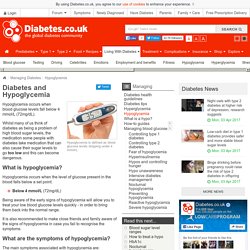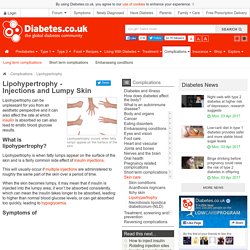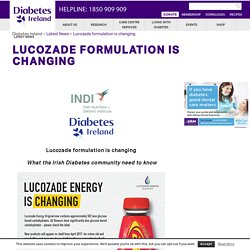

Insulin prescribing OSCE stop. PJ INsulin initiation in DM. Medscape GLP1 v DPP4. JBDS hypoglycaemia position (2013) Hypoglycemia - Symptoms, Causes and Treatment. Hypoglycemia is defined as blood glucose levels dropping under 4 mmol/L Hypoglycemia occurs when blood glucose levels fall below 4 mmol/L (72mg/dL).

Whilst many of us think of diabetes as being a problem of high blood sugar levels, the medication some people with diabetes take medication that can also cause their sugar levels to go too low and this can become dangerous. What is hypoglycemia? Hypoglycemia occurs when the level of glucose present in the blood falls below a set point: Below 4 mmol/L (72mg/dL) Being aware of the early signs of hypoglycemia will allow you to treat your low blood glucose levels quickly - in order to bring them back into the normal range.
It is also recommended to make close friends and family aware of the signs of hypoglycemia in case you fail to recognise the symptoms. What are the symptoms of hypoglycemia? The main symptoms associated with hypoglycemia are: Sweating Fatigue Feeling dizzy. Lipohypertrophy - Injections and Lumpy Skin. Lipohypertrophy occurs when fatty lumps appear on the surface of the skin Lipohypertrophy can be unpleasant for you from an aesthetic perspective and it can also affect the rate at which insulin is absorbed so can also lead to erratic blood glucose results.

What is lipohypertrophy? Lipohypertrophy is when fatty lumps appear on the surface of the skin and is a fairly common side effect of insulin injections. This will usually occur if multiple injections are administered to roughly the same part of the skin over a period of time. When the skin becomes lumpy, it may mean that if insulin is injected into the lumpy area, it won’t be absorbed consistently, which can mean the insulin takes longer to be absorbed, leading to higher than normal blood glucose levels, or can get absorbed too quickly, leading to hypoglycemia. Perioperative Management of the Diabetic Patient: Overview, Physiology of Glucose Metabolism, General Preoperative Assessment.
Pharmaceutical journal.com How to avoid the pitfalls associated with continuous IV insulin infusions. NCHD Guide. Thank you We would like to thank a number of people who made this app. possible.

Fiona Ahern (pharmacist Cork University Hospital), Frank O'Riordan (antibiotic pharmacist, Mercy University Hospital, SIVUH), Mala Shah and Paula Murphy (pharmacists, CUH), who work tirelessly to ensure the medication / antimicrobial guidelines are correct and up to date. Many thanks to Dr. Sile O'Connor for her work in preparing the BSH Tralee antibiotic guidelines. Ms. The Cork & Kerry Infection Control Committee kindly provided funding for a laptop to enable development of the mobile application.
For more comprehensive clinical guidelines please visit EMed.ie. We would like to give a special Thank You to Dr. Dr. Disclaimer The antimicrobial information contained in this App was collated by the Cork Kerry antimicrobial stewardship sub-committee and reflect the antimicrobial guidelines of the (CUH, MUH, SIVUH and Bon Secours hospitals in Tralee & Cork). Diabetic emergencies PJ. Oral hypoglycaemic drugs table. Onsdguidelinesgestationaldiabetes. GDM desktop guide revised 2015 2. Diabetes drugs mindmap. Lucozade formulation is changing - Diabetes Ireland : Diabetes Ireland. Lucozade formulation is changing What the Irish Diabetes community need to know People who have been recommended to drink Lucozade Energy Original when their blood glucose is low should be aware that the formulation of the drink is changing from April 2017 and this will not be advertised on the bottle.

Lucozade Energy Original will now contain around 50% less glucose-based carbohydrates, so the amount needed to treat hypoglycaemia will change. Hypoglycaemia, often referred to as a ‘hypo’, can be a side-effect of insulin and taking some diabetes medications. A blood glucose level below 4mmol/L is considered hypoglycaemia and if you have frequent low blood glucose levels, you should talk to your doctor as your medication may need to be reduced. If you are concerned about whether this affects you, check with your pharmacist or doctor/diabetes team to see if any of your diabetes medications puts you at risk of a low blood glucose.
Normal guidelines for treating a ‘hypo’ are: Step 1: Step 2: PJ T2DM 2015. CP T1DM 2013. CP T1DM Insulin 2013. ICGP Guide to Integrated T2D 24 2 2016 5.